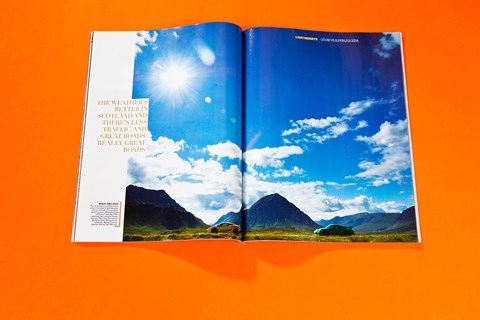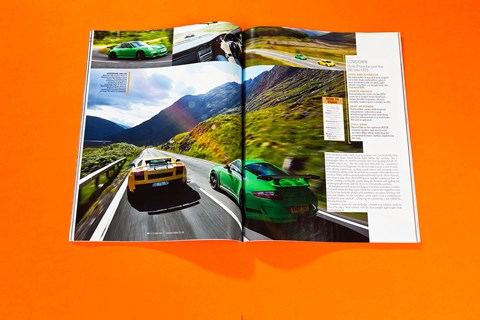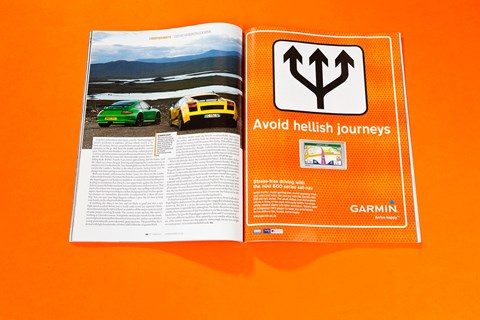► Stripped-out Lambo vs GT3 RS
► Scotland hosts lightweight powerfest
► An archive travel gem from CAR+
The Scottish Play, Porsche and Lamborghini strip weight from 911 GT3 and Gallardo to create hardcore supercars. Can Scotland’s roads cope?
Southern Britain is drowning. Torrential rain has been hammering down for days, floodwaters saturate road networks and BBC News 24 is back-to-backing footage of families being airlifted from their homes. It feels like the end of the world, an apocalyptic payback for all those pillaged oil reserves and raped rainforests and X5s parked at school gates when our obese children could have staggered home.
And perhaps it is. Maybe Al Gore’s worst case scenario isn’t so far from that inconvenient truth; that we really are deep into a vicious circle of melting ice caps and brooding, vengeful weather systems. Maybe there’s already no way back and Richmond council’s parking tax can’t save the planet after all.
Which makes the Porsche 911 GT3 RS and Lamborghini Superleggera that glow before us like Amazonian toads seem somewhat irrelevant. We need a Humvee to get through this – don’t you just love irony? – not lightweight track toys. But in a strange way, these cars are relevant, both Porsche and Lamborghini boasting cutting-edge materials to reduce mass and maximise efficiency. The 523bhp Lamborghini loses 100kg and gains 10bhp over the Gallardo it’s based on, 50% of the weight loss coming from the interior with thinner glass, reduced soundproofing and carbonfibre trim. Some steel engine components are replaced with aluminium, aluminium components giving way to pricey magnesium. Outside there are new lightweight 19in wheels – wearing 295/30 ZR19 Pirellis out back – and carbon everywhere: the mirrors, sideskirts and rear spoiler. To get less you’ll pay £25k more: around £150k.
The Porsche ditches just 20kg compared with the GT3 it’s based on with a plastic rear window and some lighter mechanicals – more on which later. Externally the lairy decals and colour combos, plus a carbon rear wing and 44mm wider hips, differentiate it from the GT3. With 409bhp, it’s no more powerful than the car it’s based on but costs almost £15k extra at £94,000.
It’s a costly business, losing weight. But once the production techniques are perfected on premium models like these, so the logic goes, the lightweight tech will ultimately filter down into lesser cars, breaking the cycle of larger engines battling extra weight through successive generations. Naturally, while the great unwashed wait for their 100kg recyclable VW Fox – Volkswagen and Porsche are bedfellows and Audi owns Lamborghini, remember – international playboys enjoy even more exciting ways to squander the remaining resources.
Right now, though, burning fossil fuels is proving something of a problem. It’s just too wet for a proper road test. Not that there isn’t hope; the weather’s better in Scotland and there’s less traffic. And great roads. Really great roads.
I plump for the GT3 RS to dispatch the 370-mile trek to the other side of Glasgow, my colleague Chris Chilton following later in the four-wheel drive Superleggera.
Now, you might argue that Porsche has shunned progress with the 911. But inside it feels instinctively right: the tactile suede steering wheel and gearknob; the upright windscreen; and the familiar, dated looking dash. The seats might be a squash for the super-sized, but they’re supportive, well padded and offer plenty of lower back support for the rest of us. Shame the upper reaches curl my shoulders into a slight hunch.
Switch the ignition, hear that breathy whirr from the naturally aspirated 3.6-litre six. The single mass flywheel shaves pounds and increases throttle response at the expense of refinement, and at idle and lesser throttle loads there’s a clattering from behind the driver that sounds much like a marble in a cement mixer. ‘What’s that awful graunching?’ your ignorant passenger will ask. You’ll tell them that they’re in a homologation special, a car built to fulfil racing regulations. ‘Oh,’ they’ll marvel.

Move off and the clutch is stickily heavy, the brakes immediately responsive yet not over-servoed. Only Lotus can match the purity of the light but incredibly detailed and communicative steering.
Northbound on the A1, the Porsche’s wipers struggle to move water from the screen fast enough, the glass mists at the edges, and I squeeze nervously at the wheel as the RS fidgets disconcertingly on its track-biased Michelin Cup Sport tyres with their outrageous 305/30 ZR19 rear footprint. I’d feel safer hang-gliding through an electric storm.
On the return trip in even worse conditions, the four-wheel drive Lamborghini will track straight and true, its Pirelli P-Zero Corsas chomping through the wet with ease. I’ll feel grateful for its bulkier heft and make a mental note that little else would feel so sure-footed. For now I’ve got Technicolour FEAR playing through the windscreen at 55mph.
Only when the M6 cuts into Cumbria do things improve. The asphalt dries, traffic clears and I squeeze the throttle hard for the first time. Third rushes to the red line and I involuntarily shout out loud. Grab the gearlever, slide through the initial slack and tug it beyond the stubborn threshold to fourth. A hard mechanical shriek bellows through the pared-down cabin, imploring you to wind out the flat six to its 7600rpm power peak. Waaaaee-ya. Waaaaee-ya. The lightweight rear screen wobbles and the few following cars reduce to smeary dots in the distance.
Beyond Penrith, past Carlisle, over the border. A brief shower gives way to the golden light of a late Scottish evening and three empty lanes stretch into the distance, lilting gently between blonde, grassy hillsides. HGVs are back-lit with a halo of spray, grazing cows cast freakishly long shadows and dense black clouds loom before the sunshine like a photographic filter. It’s hard to reconcile that we’re heading directly for Scotland’s largest city – like the roads have been built for a population explosion that never happened. For the first time in years I start to really enjoy driving a motorway, scything round corners and swooping across deserted lanes. All the while the 911 feels reassuringly solid and connected to tarmac. There’s no float, no slack and even the ride’s good – driver-focused, sure, but never crashy. Press the PASM button and the suspension firms up further, sending a noticeable tremor along the floorpan and jiggling the unsprung weight a little clumsily. Best save it for smooth racetracks.
An 80mph cruise delivers me to Glasgow’s outskirts. Even after 300 miles I feel fresh, where the long return trip in the Lambo’s less supportive seats will leave my backside prickly with numbness, my palms bristling with pins and needles. So the very place you’d expect such a track-focused machine to come unstuck – a long trip on a motorway – has ruffled the Porsche not one bit.
Tomorrow comes the real challenge: a thrash over tortuous roads to Glen Coe and a head-to-head with the heavyweight lightweight from Lamborghini.
And so the morning dawns bright and clear and I make timidly for the Lamborghini. It’s very, very different in here. I’m 6 foot 2 and my hair catches against the roof like it would a static-infused party balloon; the windscreen rakes extravagantly forward and what isn’t carbonfibre is wrapped in suede. It’s harder to just get in and drive the Superleggera than it is the Porsche, requiring you to grapple with a four-point harness – seatbelts are available, as are six-point harnesses in the Porsche – and the compromised view out back makes it hard to manoeuvre in tight spaces. So it’s more of a hassle than the 911, but more of a ritual too.
Turn the key, hear the fuel pump buzz into action, crank over that V10 for twice as long as you think necessary… duluduwoooeeeeeeBOOM! The first time I went through this exquisite start-up procedure, I flinched like someone had shouted ‘boo!’ mid-daydream. And by then I was already surrounded by schoolkids, already absent-mindedly answering questions as I pressed the brake pedal and pushed the button to select reverse: ‘five litres’, ‘197mph’, ‘no you can’t have those dust caps for your bike’.
The Lamborghini recalibrates the world around it, making everything else – nuclear green Porsche included – appear muted and dull in comparison. We cruise the outskirts of town and a whole family spins on their heels, a teenager drops to his knees in mock worship and a kid on a bike impulsively waves – weaving into traffic in the process. At the lights an attractive young nurse gazes over. ‘Nice Lambo,’ she blushes. So this is how premiership footballers wind up in so much trouble.
Out of town the A814 peaks and troughs and flows alongside Loch Long. It’s a very fast – if not particularly well-sighted – road, once used to take weapons-bearing lorries to Coulport. The deadly cargo would then be loaded onto submarines and fired up the loch at maximum velocity. How apt.

Grip the Lambo wheel, select Sport, aim, fire. The Superleggera doesn’t accelerate; it explodes. All four wheels snatch at the bone-dry tarmac, the car catapults forward and neck muscles capitulate to the gs. Pull back the paddle and BANG, second gear. The drivetrain shudders, rear tyres chirp, violent proof of a vicious, specially commissioned software recalibration. Third. BANG. The Porsche’s nose tilts skyward under power, but it’s falling back. BANG. Fourth. Fast corner approaching, dab the brakes, turn the wheel. 911 closes the gap. Steering and stopping the Lambo just isn’t as intuitive as it is in the Porsche. Your hands glide over the Porsche wheel, they wrestle the Lambo’s. Neither is the wheel as tactile, feeling fatter and the change in texture jarring as you feed round that
carbonfibre bottom.
Both cars feature carbon ceramic brakes (yours for £8107 on the Lambo, £5800 on the Porsche), but where the Porsche’s are immediate and progressive, the Superleggera’s are harder to modulate, an initial chasm of nothingness leading to retardation that thwacks your upper body against the harnesses. At first you use the brakes too hard, but you learn to trust in their reserves. They need a bit of heat too. Great gearchange though, Auto gelling well with your inputs, Sport leaving everything to you bar changing down at very low speeds. Up-changes are immediate, downshifts accompanied by a show-off rorty blip. You can spec your Superleggera without e-gear, but it’s nice to keep your hands on the wheel with this firepower.
If anything the A814 is too fast and too likely to goad you into a very high-speed accident before you’ve really understood any supercar’s limits. So we thread along the A82 to Glen Coe and dive off the major routes in search of some proper, twisting B-roads. The scenery is epic up here, like nature’s working at a broader canvas. Vertiginous mountains stretch for the clouds, rivers of glacial moraine flow down their lower reaches, and ice-carved valleys swoop panoramically across deserted, peaty pastures. The pastel blue sky is dotted with light brushstrokes of white and fat blotches of granite black.
On these smaller roads the Porsche is untouchable, keying into the surface and feeding back the intricacies of grip and camber and surface texture with distortion-free clarity. Slim pillars and that upright ’screen make it easy to place on the road too. Careful not to go into bends too hot, though – with the nose loaded up, an extra jab at the throttle sends the 911 scurrying into understeer. Learn instead 4 to get the weight distribution working, feel the mass over the rear aid traction and tuck the nose into bends once you’ve lifted off the gas just before entering the corner.
Where the Porsche shines the Lamborghini falters. It feels wider, heftier and its raked windscreen makes seeing through corners harder. While the solid suspension reassured on fast A-roads, it now bumps around tiresomely. It’s quick, but it can’t keep in touch with the 911 here. Yet as we pull into a scenic lookout, it’s the Lambo that bikers swarm around, drawn to its epically architectural looks and recognising it as one of few cars capable of catching them on the broader sweepers round these parts.
Reluctantly, eventually, we head south once more, brush past the shores of Loch Lomond and descend into a still inundated England. We’ve covered more than 500 miles in each car, taking in some of the finest driving roads Britain can offer, and the sort of testing playground these serious performers were engineered for. The Porsche proved itself to be a surprisingly adept all-rounder. It’s a car that you honestly could live with day-to-day and, of our duo, the one that better suits more of Britain’s roads more of the time. It even returned 27mpg on a quick motorway blast. I want one, but I’d never be able to justify the £15k premium it carries over the regular GT3. Somehow, brilliant and ultimate though any 911 is to a keen driver, it seems wrong to flirt with a six-figure pricetag for this car – like you’ve misunderstood the kismetic simplicity that makes 911s rock and decided instead to use the Porsche as a badge of opulence. Dynamically it’s a Lamborghini rival, but financially it’s elsewhere – apart.
It’s hard too to justify the £25k extra it requires to move from bog standard Lamborghini Gallardo (itself hardly an act of understatement) to Superleggera, and you won’t spend much time at dinner parties advertising the frankly absurd 11mpg that we achieved on the motorway. No planet can withstand such abuse, let alone Earth. But this is a car for the extravagant. And for pure, over-the-top entertainment, it’s got to be the Lamborghini. The fabulous, Hot-Wheels-model-in-real-life looks, the sense of occasion and the sheerexplosiveness of that V10 endear it you like no other car. Sure it has its flaws, but give the Superleggera space to shine and it’s exceptional.
Two very different machines, then, united by a very similar ethos – and one that may prove to inform the future. But believe me, if the current climate sees the industry increasingly favour less weight over more power, we’re in for one hell of a ride.
